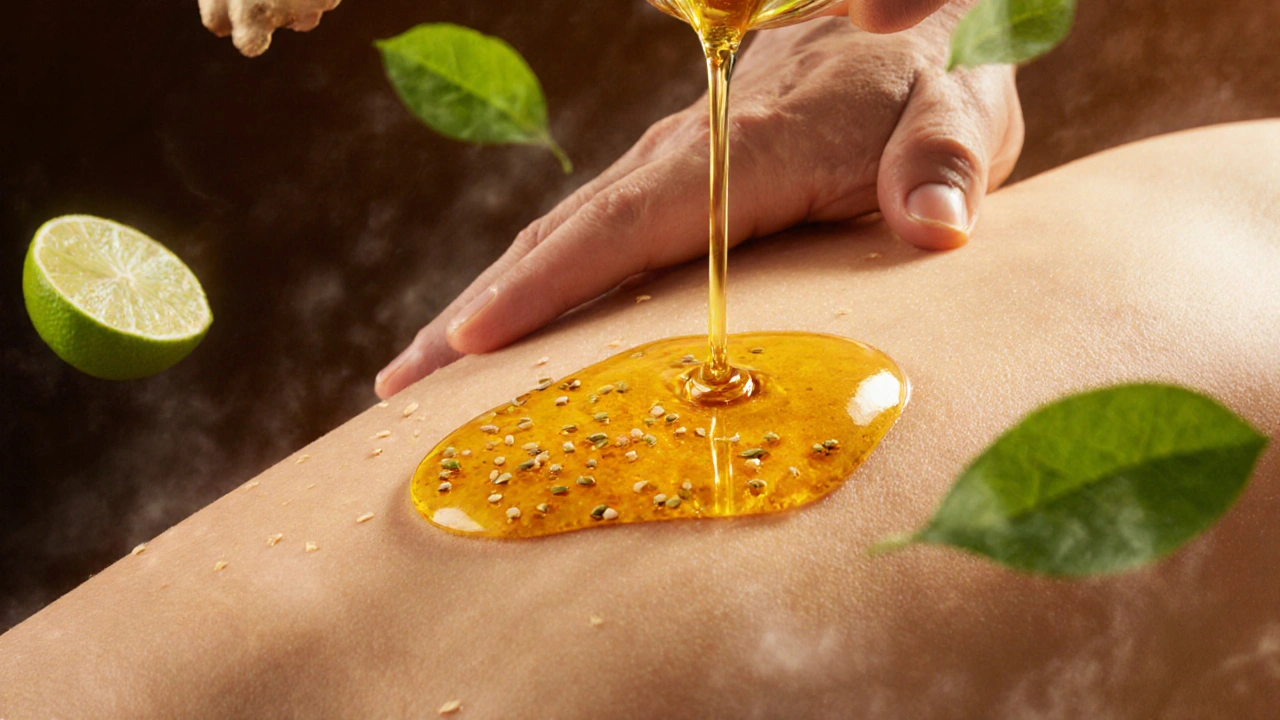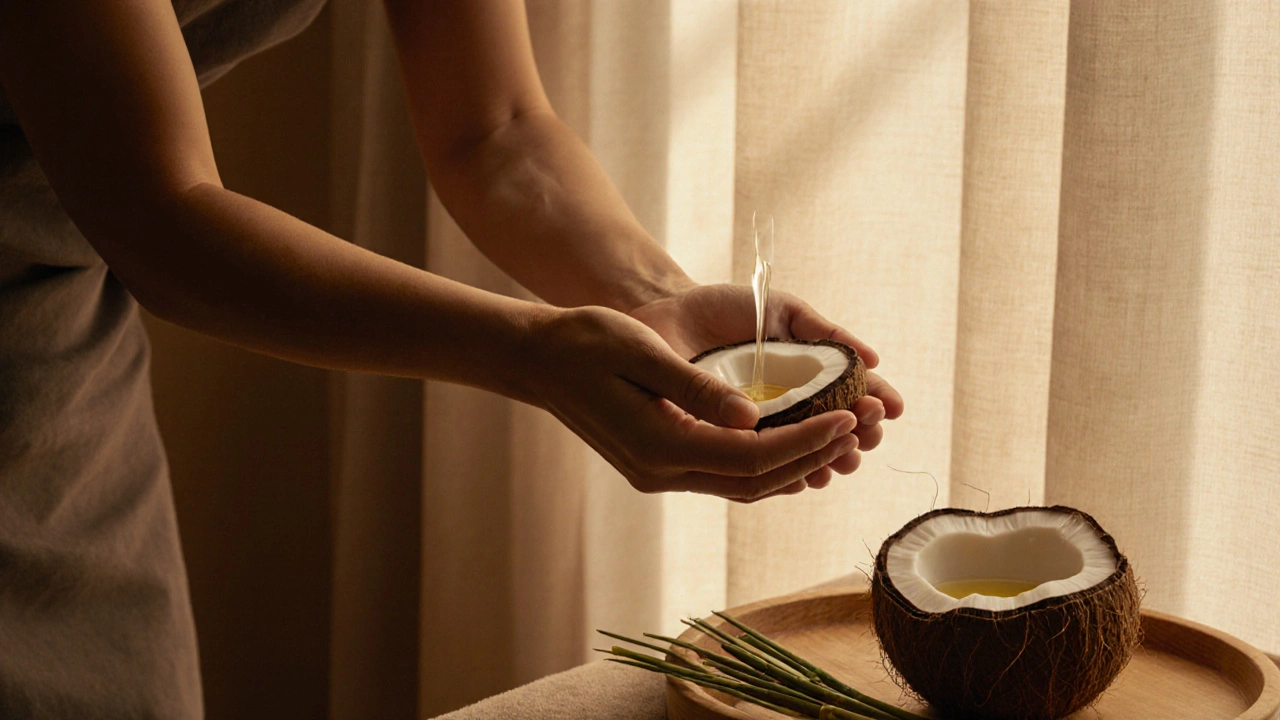Key Takeaways
- Traditional Thai massage relies on oils to enhance flow, reduce friction, and deliver herbal benefits.
- Coconut oil, sesame oil, and turmeric-infused blends are the most trusted oils used in authentic Thai massage.
- Each oil has unique properties-coconut cools and hydrates, sesame warms and grounds, and herbal blends target pain and inflammation.
- Always test oils on a small patch of skin first, especially if you have sensitive skin or allergies.
- Avoid synthetic fragrances and cheap mineral oils-they clog pores and defeat the purpose of natural therapy.
What Makes Thai Massage Oil Different?
You’ve probably seen Thai massage on YouTube-therapists moving like dancers, stretching limbs, pressing along energy lines. But what you don’t always see? The oil. It’s not just a slick layer to make hands glide. In traditional Thai massage, oil is part of the medicine.
Unlike Swedish or deep tissue massage, where oil is optional, Thai massage uses oil as a carrier for healing herbs and a tool to activate circulation. The right oil warms the muscles, opens the energy channels (sen lines), and helps the body absorb botanicals that reduce swelling, ease stiffness, and calm the nervous system.
Think of it this way: the stretches and pressure do the work, but the oil? It’s the quiet partner that makes everything smoother, deeper, and more effective.
Why Oil Matters in Thai Massage
If you’ve ever had a massage without enough oil, you know how it feels-dragging skin, discomfort, even tiny tears. That’s not healing. That’s friction.
Thai massage involves long, rhythmic strokes, deep compression, and full-body stretching. Without proper lubrication, you’re not just wasting time-you’re risking irritation. But it’s not just about slip. The oil carries the active ingredients that make Thai massage more than just physical manipulation.
Herbal oils have been used in Thai healing for centuries. They’re not trendy. They’re rooted in Ayurvedic and traditional Southeast Asian medicine. When you feel that warm, earthy scent during a session, you’re not just smelling lavender-you’re inhaling turmeric, lemongrass, or ginger that’s been steeped into the base oil for days.
Studies from Chiang Mai University show that herbal oils used in Thai massage significantly reduce muscle soreness and improve joint mobility after just three sessions. That’s not placebo. That’s phytochemistry at work.
The Top 4 Thai Massage Oils and Their Benefits
1. Coconut Oil - The Gentle Healer
Coconut oil is the most common base in Thai massage, especially in northern Thailand. Why? It’s light, absorbs quickly, and doesn’t leave a greasy film. But its magic isn’t just texture-it’s lauric acid, a natural anti-inflammatory and antimicrobial compound.
If you have sensitive skin, acne-prone skin, or just hate feeling oily after a massage, coconut oil is your best bet. It cools the body, soothes sunburn, and helps repair the skin barrier. Many therapists blend it with a few drops of jasmine or lemongrass for a calming effect.
Pro tip: Use cold-pressed, unrefined coconut oil. Refined versions lose most of the healing compounds.
2. Sesame Oil - The Deep Warming Base
Sesame oil is the go-to in southern Thai traditions. It’s thicker than coconut oil, with a nutty aroma and a warming effect. In Ayurveda, it’s called a "vata-balancing" oil-perfect for people who feel cold easily, have stiff joints, or suffer from chronic tension.
Sesame oil is rich in vitamin E and antioxidants, which fight free radicals and slow skin aging. It also penetrates deeper than coconut oil, making it ideal for slow, deep-pressure techniques.
Therapists often heat sesame oil slightly before use. Not hot enough to burn-just warm enough to open the pores and help the herbs sink in. It’s the oil of choice for older clients or those with arthritis.
3. Turmeric-Infused Oil - The Pain Reliever
If you’ve ever had a Thai massage after a long flight or a tough workout, you’ve probably felt the golden glow of turmeric oil. It’s not always obvious-sometimes it’s just a faint yellow tint and a warm, spicy scent.
Turmeric contains curcumin, one of the most powerful natural anti-inflammatories on the planet. Studies in the Journal of Medicinal Food show curcumin reduces muscle pain as effectively as ibuprofen, without the stomach upset.
Therapists infuse turmeric powder into sesame or coconut oil and let it sit for weeks. The oil turns golden, smells earthy, and works like a slow-release painkiller. It’s perfect for sore shoulders, lower back pain, or stiff hips.
Warning: It can stain light fabrics. Always wear dark clothes after a session.
4. Herbal Blends - The Secret Weapon
High-end Thai massage studios don’t just use one oil-they mix. A signature blend might include: ginger for circulation, kaffir lime for detox, plai (Thai turmeric) for deep muscle relief, and camphor for a cooling tingle.
These blends are often made in small batches by local herbalists. Some are passed down through families. The best ones come from northern Thailand, where herbal medicine is still taught in temples.
Look for oils labeled "traditional Thai herbal blend" or "100% natural infusion." Avoid anything that says "fragrance oil" or "artificial scent." Real herbal oil smells complex-not like a perfume bottle.

What to Avoid in Thai Massage Oils
Not all oils are created equal. Some brands cut corners to save money-and it shows.
Mineral oil is a petroleum byproduct. It sits on the skin like plastic, blocking pores and trapping toxins. It has zero healing properties. If your massage feels greasy but doesn’t absorb, you’re probably getting mineral oil.
Synthetic fragrances are a red flag. They cause allergic reactions and irritate the nervous system-exactly what you’re trying to calm down during a massage.
Low-quality coconut oil that’s been bleached or deodorized loses its nutrients. It might smell fine, but it’s just oil with a mask on.
Always ask: "Is this oil infused with herbs?" If the answer is vague, walk away.
How to Choose the Right Oil for You
Not everyone needs the same oil. Your body type, skin condition, and goals matter.
- For dry or sensitive skin: Go with cold-pressed coconut oil. Gentle, hydrating, non-irritating.
- For cold hands/feet or chronic stiffness: Sesame oil is your friend. It brings warmth and deep relaxation.
- For muscle pain, sports recovery, or arthritis: Turmeric or herbal blends. The anti-inflammatory effect is real.
- For relaxation and stress relief: Coconut oil with a touch of lavender or orange blossom. Calms the mind without drowsiness.
And if you’re unsure? Ask your therapist. A good one will know exactly which oil suits your needs.
Can You Use Thai Massage Oil at Home?
Yes-and you should. Thai massage isn’t just for spas. It’s a daily wellness practice.
After a long day, warm a tablespoon of coconut or sesame oil in your hands. Massage it into your feet, calves, and lower back. Use slow, circular motions. Focus on areas that feel tight.
Do this for 10 minutes before bed. You’ll sleep deeper. Your muscles will thank you. And you’ll start to notice the difference in how your body moves the next day.
Many Thai families use herbal oil for their kids’ growing pains or elderly parents’ joint stiffness. It’s not luxury-it’s everyday care.
Where to Buy Authentic Thai Massage Oil
You won’t find real Thai herbal oil in big-box stores. Look for small, ethical brands that source directly from Thailand.
Check out:
- Chiang Mai Herbal - Based in northern Thailand, they make small-batch oils using temple recipes.
- Thai Herbal Apothecary - Ships internationally. Their turmeric-sesame blend is a cult favorite.
- Local Thai markets in London - Try the Thai shops in Brick Lane or Camden. Ask for "น้ำมันนวดไทย" (nam man nuat thai).
A good bottle costs £18-£35. If it’s under £10, it’s not real.

What to Expect During a Thai Massage with Oil
When you lie down, the therapist will warm the oil between their palms. You’ll smell something earthy-maybe ginger, maybe lemongrass. They won’t drench you. Just enough to let their hands glide.
The session starts with gentle strokes along your back, then moves to legs, arms, and feet. You’ll feel pressure, but not pain. The oil helps the therapist apply deep pressure without dragging your skin.
As they stretch your limbs, you might feel a slight warmth spreading through your muscles. That’s the oil working. By the end, your skin feels soft, your joints feel loose, and your mind feels quiet.
And here’s the best part: you won’t feel greasy. Real Thai oil absorbs in 20-30 minutes. You can even wear light clothes afterward.
Comparison: Thai Massage Oil vs. Other Massage Oils
| Oil Type | Best For | Absorption | Herbal Benefits | Heat Response |
|---|---|---|---|---|
| Thai Herbal Oil | Deep tissue, pain relief, energy flow | Medium to slow | High-turmeric, ginger, plai | Warms naturally |
| Coconut Oil (pure) | Sensitive skin, hydration | Fast | Moderate-lauric acid only | Cooling |
| Sesame Oil (pure) | Stiff joints, cold body | Slow | Moderate-vitamin E, antioxidants | Warming |
| Almond Oil | Light massage, general relaxation | Medium | Low | Neutral |
| Mineral Oil | Low-cost, no benefits | None | None | None |
Frequently Asked Questions
Can I use coconut oil for Thai massage at home?
Yes, coconut oil is one of the best options for home use. It’s gentle, absorbs quickly, and has natural anti-inflammatory properties. Just make sure it’s cold-pressed and unrefined. Warm it slightly in your hands before applying for best results.
Is turmeric oil safe for all skin types?
Most people tolerate turmeric oil well, but it can stain light skin or clothing. Always do a patch test first. If you have very sensitive skin, mix it with coconut oil to dilute the potency. Avoid using it on open wounds or broken skin.
Why does Thai massage oil smell different from regular massage oil?
Because it’s made with real herbs-not synthetic perfume. Thai herbal oils are infused with ingredients like lemongrass, kaffir lime, ginger, and turmeric. The scent is earthy, spicy, and slightly medicinal. That’s a sign it’s authentic. If it smells like a candle, it’s not real.
How long does Thai massage oil last?
Homemade or small-batch herbal oils last 6-12 months if stored in a cool, dark place. Avoid sunlight and heat. If the oil smells rancid or changes color, toss it. Never use expired oil-it can irritate your skin.
Can I mix my own Thai massage oil?
Absolutely. Start with a base of coconut or sesame oil. Add 1-2 teaspoons of dried turmeric powder, a few crushed ginger slices, or a drop of lemongrass essential oil. Let it sit for a week in a sealed jar, then strain. Test on your wrist before full use. It’s cheaper and more personal than store-bought.
Ready to Feel the Difference?
Thai massage isn’t just about relaxation-it’s about restoring your body’s natural rhythm. And the oil? It’s not a luxury. It’s the bridge between pressure and healing.
Try one of the oils mentioned here. Use it at home. Book a session with a therapist who uses real herbal blends. Your muscles, your joints, and your nervous system will notice the difference.
Don’t settle for slick, scentless oil. Your body deserves better.

